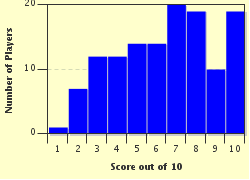Quiz Answer Key and Fun Facts
1. Ordered by King Ethelred in 1002, the St. Brice's Day Massacre involved the killing of which of these?
2. King Canute became the English king in 1016, and the following year he divided the country into four earldoms. Three of them were Wessex, East Anglia and Northumbria. Which was the fourth?
3. Which of these men, destined to become important in England's history later in the century, were born in the 1020s?
4. King Canute died in 1035, and was succeeded by his son, who became Harold I. By what nickname was Harold known?
5. In 1040 Macbeth became king of Scotland. Although Shakespeare concocted much of the history in the play bearing that name, he did get the name of Macbeth's predecessor correct. What was it?
6. Gruffydd ap Llywelyn, the Welsh king, attacked which city of the Welsh Marches in 1055?
7. Which of these places of worship, still much in use for Royal occasions nearly a thousand years later, was consecrated in December 1065?
8. The 1070s saw rebellions against the Normans, led by Hereward the Wake. In which part of England was his base?
9. The Domesday Book was completed in 1086. Was it known by the same name in the 11th century?
10. Although the date of its foundation has not been recorded, evidence of teaching exists from 1096 at which well known place of learning?
Source: Author
rossian
This quiz was reviewed by FunTrivia editor
gtho4 before going online.
Any errors found in FunTrivia content are routinely corrected through our feedback system.

